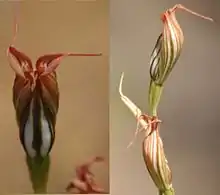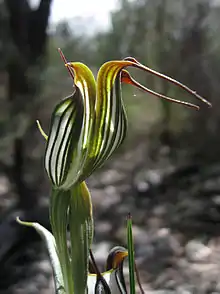Pterostylis recurva
Pterostylis recurva commonly known as the jug orchid, recurved shell orchid, antelope orchid or bull orchid,[3] is a plant in the orchid family Orchidaceae and is endemic to the south-west of Western Australia. It is a relatively common orchid which has up to four jug-shaped or funnel-shaped white flowers with green and brown lines and markings. Non-flowering plants have a rosette of leaves on a short stalk.
| Jug orchid | |
|---|---|
 | |
| Flowers of Pterostylis recurva | |
| Scientific classification | |
| Kingdom: | Plantae |
| Clade: | Tracheophytes |
| Clade: | Angiosperms |
| Clade: | Monocots |
| Order: | Asparagales |
| Family: | Orchidaceae |
| Subfamily: | Orchidoideae |
| Tribe: | Cranichideae |
| Genus: | Pterostylis |
| Species: | P. recurva |
| Binomial name | |
| Pterostylis recurva | |
| Synonyms[2] | |
Description
Pterostylis recurva, is a terrestrial, perennial, deciduous, herb with an underground tuber. Non-flowering plants have a rosette of between three and seven leaves 7–40 mm (0.3–2 in) long and 5–15 mm (0.2–0.6 in) wide. Flowering plants lack a rosette but have between ten and sixteen stem leaves which are 30–50 mm (1–2 in) long and 10–12 mm (0.4–0.5 in) wide with their bases wrapped around the flowering stem. Up to four white flowers with green and brown lines are borne on the flowering stem which is 150–900 mm (6–40 in) high. The flowers are jug-shaped or funnel-shaped, 30–35 mm (1.2–1.4 in) long and 15–25 mm (0.6–1 in) wide. The dorsal sepal and petals form a hood or "galea" over the column with the dorsal sepal having a narrow tip 4–6 mm (0.2–0.2 in) long. The lateral sepals are joined for about half their length and suddenly taper to narrow tips 23–26 mm (0.91–1.0 in) long which turn sharply downwards. The labellum is reddish, insect-like and held inside the flower except for its tip. Flowering occurs from August to October.[3][4][5]

Taxonomy and naming
Pterostylis recurva was first formally described in 1873 by George Bentham and the description was published in Flora Australiensis.[1][3][6] The specific epithet (recurva) is a Latin word meaning "bent backward"[7] referring to the downcurved lateral sepals.[3]
Distribution and habitat
The jug orchid is found in woodland, shrubland, forest and in shallow soil on granite outcrops. It grows in sand, clay, laterite and gravel soils and is common and widespread between Geraldton and Israelite Bay.[3][4][5][8]
Conservation
Pterostylis recurva is classified as "not threatened" by the Western Australian Government Department of Parks and Wildlife.[8]
References
- "Pterostylis recurva". APNI. Retrieved 10 July 2017.
- "Pterostylis recurva". World Checklist of Selected Plant Families (WCSP). Royal Botanic Gardens, Kew.
- Brown, Andrew; Dundas, Pat; Dixon, Kingsley; Hopper, Stephen (2008). Orchids of Western Australia. Crawley, Western Australia: University of Western Australia Press. pp. 402–403. ISBN 9780980296457.
- Jones, David L. (2006). A complete guide to native orchids of Australia including the island territories. Frenchs Forest, N.S.W.: New Holland. pp. 337–338. ISBN 978-1877069123.
- Hoffman, Noel; Brown, Andrew (2011). Orchids of South-West Australia (3rd ed.). Gooseberry Hill: Noel Hoffman. p. 417. ISBN 9780646562322.
- Bentham, George (1873). Flora Australiensis Volume 6. London: Lovell Reeve & Co. p. 360. Retrieved 10 July 2017.
- Brown, Roland Wilbur (1956). The Composition of Scientific Words. Washington, D.C.: Smithsonian Institution Press. p. 139.
- "Pterostylis recurva". FloraBase. Western Australian Government Department of Parks and Wildlife.